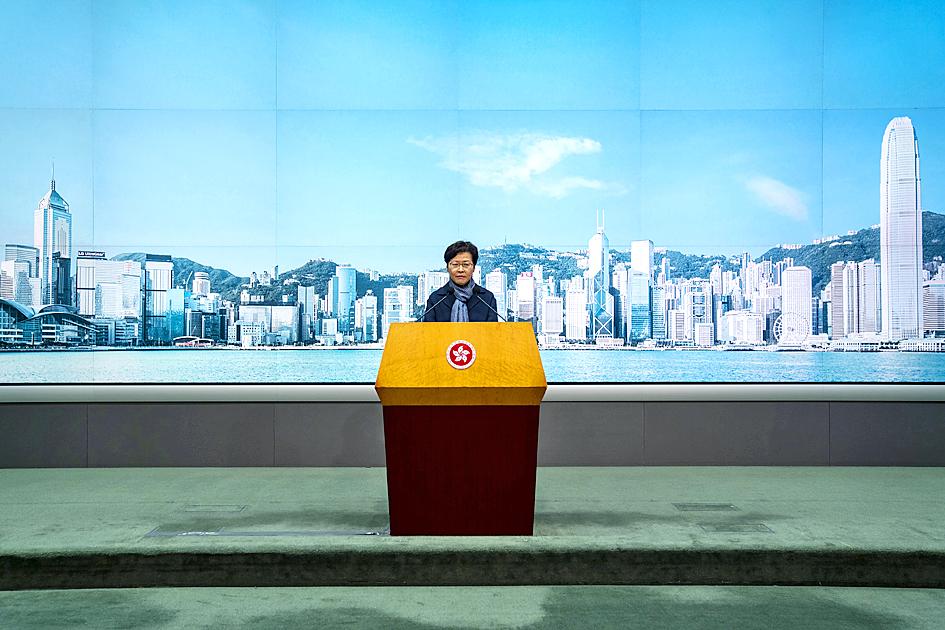Hong Kong is to postpone the election of its next leader until May 8 as it grapples with a worsening COVID-19 outbreak, yesterday reporting 15 deaths related to the virus and more than 6,000 cases.
Hong Kong Chief Executive Carrie Lam (林鄭月娥) on Friday said that the election would be delayed by six weeks from March 27, as holding the polls as originally scheduled would pose “public health risks,” even if a committee of only 1,462 people is involved.
Hong Kong’s leader is elected by a committee made up of legislators, representatives of various industries and professions, as well as Hong Kong deputies to the Chinese legislature and other pro-Beijing representatives.

Photo: Bloomberg
Several candidates including film producer Checkley Sin (冼國林) and Titus Wu, a former member of Hong Kong’s largest pro-establishment political party, have confirmed their intention to run.
It is not clear whether Lam will run for re-election.
Hong Kong yesterday confirmed 6,063 cases in the previous 24 hours, raising the territory’s total to 46,763.
Daily new cases exceeded 2,000 for the first time on Monday. On Friday, more than 3,600 new local infections were reported.
Health authorities on Thursday said that the territory’s hospitals were at 90 percent capacity and that its isolation facilities were full.
The Hong Kong government yesterday said that temporary isolation and treatment units would be built in the Penny’s Bay and Kai Tak districts.
Mainland Chinese crews have experience constructing hospitals quickly after two facilities with 1,500 and 1,000 beds were built within 10 days early in the COVID-19 pandemic in Wuhan, the center of the initial outbreak of the virus. They also converted 16 other buildings into isolation hospitals.
Lam said her government would also use hotel rooms, sports facilities and newly built public housing units to hold patients.
Hong Kong Hospital Authority chief executive Tony Ko (高拔陞) apologized in a radio broadcast after patients were forced to wait outdoors.
He said most of them had been moved indoors or to other facilities.
Lam also said there were plans to test the territory’s entire population for COVID-19, but denied that Hong Kong would be put under a strict lockdown even as it pursues a “zero COVID-19” approach.
“Mandatory testing and a complete city lockdown may not need to go hand in hand. It depends on the actual situation,” she said. “In our case, having examined the unique situation in Hong Kong, we’ll probably just go for universal testing of everyone, but testing more times.”
She cited as an example Macau, which has tested its entire population twice for the virus.
Hong Kong has aligned itself with mainland China’s strict policy to stamp out any COVID-19 transmissions, pursuing a policy that involves quarantining incoming travelers, total lockdowns, extensive contact tracing and mass testing of millions of people.
Lam has stuck to the same strategy, despite the territory’s greater population density, higher incomes and more service-oriented economy than in mainland China.
Last week, the entire upscale Discovery Bay neighborhood in Hong Kong was ordered to undergo testing after authorities found traces of the virus in its sewage.

SECURITY: As China is ‘reshaping’ Hong Kong’s population, Taiwan must raise the eligibility threshold for applications from Hong Kongers, Chiu Chui-cheng said When Hong Kong and Macau citizens apply for residency in Taiwan, it would be under a new category that includes a “national security observation period,” Mainland Affairs Council (MAC) Minister Chiu Chui-cheng (邱垂正) said yesterday. President William Lai (賴清德) on March 13 announced 17 strategies to counter China’s aggression toward Taiwan, including incorporating national security considerations into the review process for residency applications from Hong Kong and Macau citizens. The situation in Hong Kong is constantly changing, Chiu said to media yesterday on the sidelines of the Taipei Technology Run hosted by the Taipei Neihu Technology Park Development Association. With

CARROT AND STICK: While unrelenting in its military threats, China attracted nearly 40,000 Taiwanese to over 400 business events last year Nearly 40,000 Taiwanese last year joined industry events in China, such as conferences and trade fairs, supported by the Chinese government, a study showed yesterday, as Beijing ramps up a charm offensive toward Taipei alongside military pressure. China has long taken a carrot-and-stick approach to Taiwan, threatening it with the prospect of military action while reaching out to those it believes are amenable to Beijing’s point of view. Taiwanese security officials are wary of what they see as Beijing’s influence campaigns to sway public opinion after Taipei and Beijing gradually resumed travel links halted by the COVID-19 pandemic, but the scale of

A US Marine Corps regiment equipped with Naval Strike Missiles (NSM) is set to participate in the upcoming Balikatan 25 exercise in the Luzon Strait, marking the system’s first-ever deployment in the Philippines. US and Philippine officials have separately confirmed that the Navy Marine Expeditionary Ship Interdiction System (NMESIS) — the mobile launch platform for the Naval Strike Missile — would take part in the joint exercise. The missiles are being deployed to “a strategic first island chain chokepoint” in the waters between Taiwan proper and the Philippines, US-based Naval News reported. “The Luzon Strait and Bashi Channel represent a critical access

Pope Francis is be laid to rest on Saturday after lying in state for three days in St Peter’s Basilica, where the faithful are expected to flock to pay their respects to history’s first Latin American pontiff. The cardinals met yesterday in the Vatican’s synod hall to chart the next steps before a conclave begins to choose Francis’ successor, as condolences poured in from around the world. According to current norms, the conclave must begin between May 5 and 10. The cardinals set the funeral for Saturday at 10am in St Peter’s Square, to be celebrated by the dean of the College